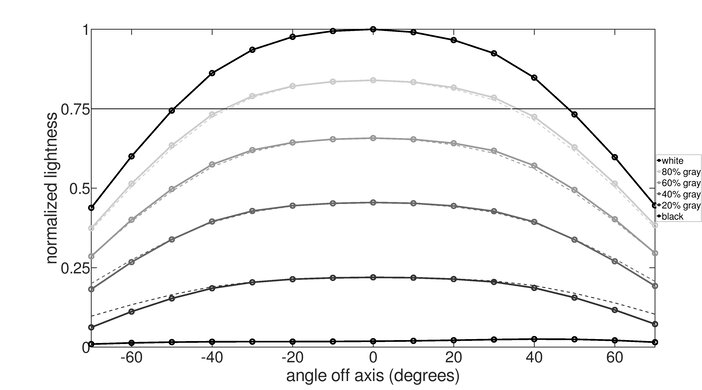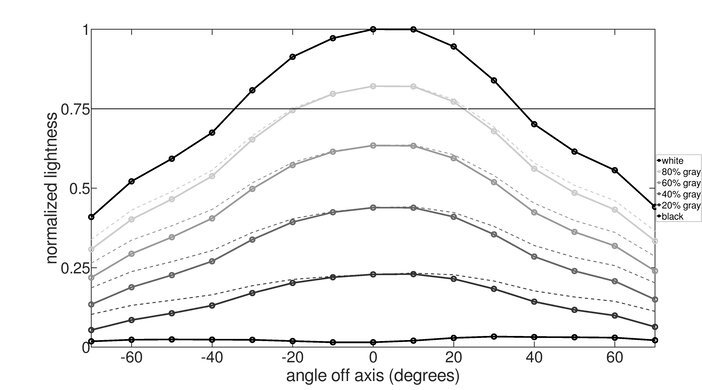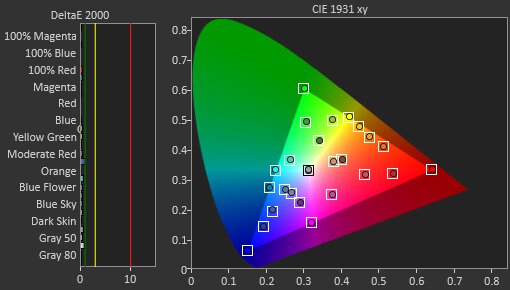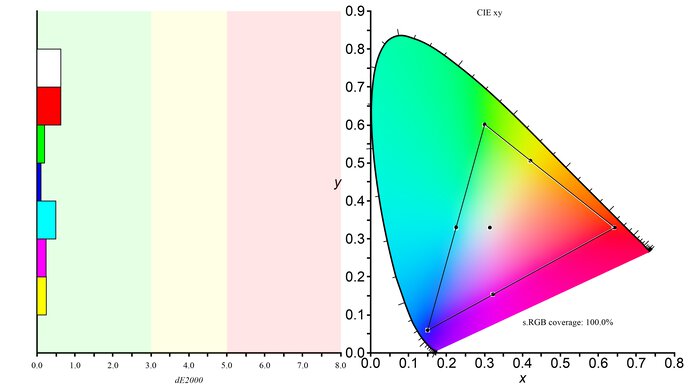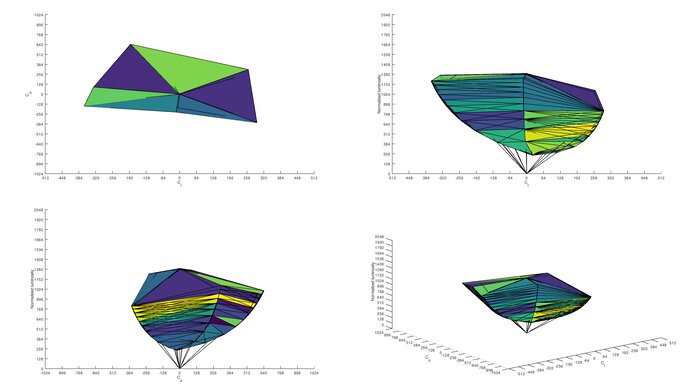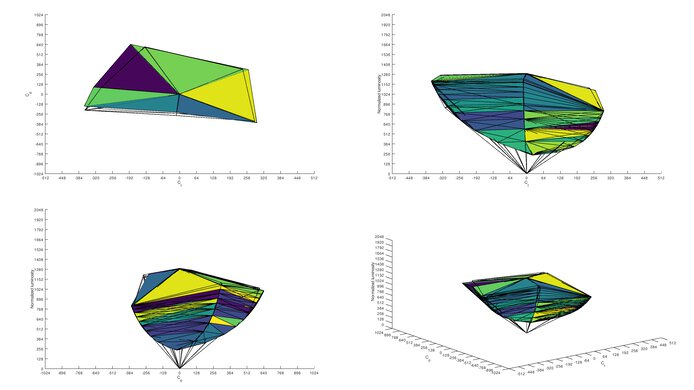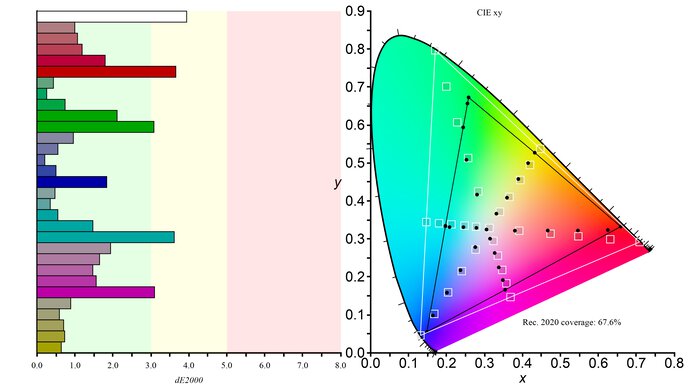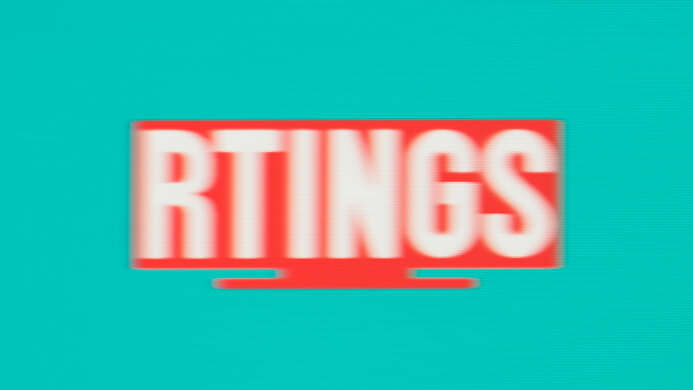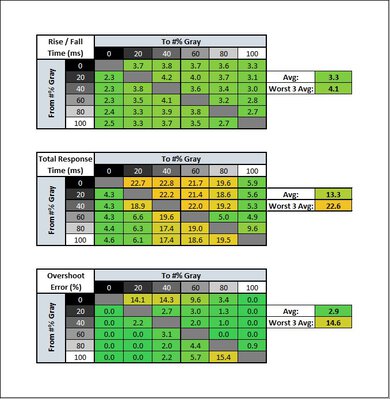The LG 27GN800-B is a great gaming monitor from LG's UltraGear lineup. It's very similar to the LG 27GN850-B/27GN880-B with a nearly identical panel but a much cheaper stand, so don't expect much ergonomic adjustability. When it comes to gaming, it delivers exceptionally smooth motion thanks to its fast response time and 144Hz refresh rate. It also has low input lag and variable refresh rate (VRR) support. Like other IPS panels, it has a low contrast ratio that makes blacks look gray in the dark, but on the upside, its viewing angles are wide enough to easily share content on your screen. Glare shouldn't be an issue either since it gets quite bright and has great reflection handling. While it has a wide HDR color gamut and delivers an okay HDR experience, it doesn't get bright enough to make highlights truly pop. On the upside, it has a fantastic color gamut in SDR.
Our Verdict
The LG 27GN800-B is a decent all-around monitor. It delivers exceptionally smooth motion due to its high refresh rate and fast response time. Gamers should also be pleased with its low input lag and VRR support. The size and resolution are well-suited to multitasking and productivity, and it has a wide SDR color gamut and gets bright enough to overcome glare. It's less suited to HDR gaming because of its low contrast ratio and mediocre HDR brightness.
- Exceptionally fast response time.
- Bright enough to fight glare.
- Size and resolution are well-suited for many uses.
- Poor contrast ratio.
- Cheap stand with terrible ergonomics.
The LG 27GN800-B is a decent office monitor. It can overcome glare in bright lighting conditions thanks to its high peak brightness and reflection handling. It's big enough to open windows side-by-side, and its 1440p resolution delivers a crisp image. Unfortunately, it has terrible ergonomics, so you'll need to mount it if you want more adjustability in terms of placement and viewing position.
- Bright enough to fight glare.
- Good size and resolution for multitasking.
- Cheap stand with terrible ergonomics.
The LG 27GN800-B is great for gaming. It has a high refresh rate, exceptionally fast response time, and low input lag. It also supports VRR to reduce screen tearing. Unfortunately, it has a low contrast ratio, so blacks look grayish, and it has terrible ergonomics, so you may have to mount it to get your ideal viewing position.
- Exceptionally fast response time.
- Low input lag.
- Native FreeSync and G-SYNC compatible.
- Poor contrast ratio.
The LG 27GN800-B is decent for multimedia. Its size is large enough to comfortably watch movies or videos, and the 1440p resolution produces a crisp image. It also has great reflection handling and high peak brightness, so glare shouldn't be an issue. Unfortunately, it has a poor contrast ratio that makes blacks look gray. On the upside, its wide viewing angles make it easy to watch with a friend or from an angle.
- Bright enough to fight glare.
- Wide viewing angles.
- Big enough to comfortably watch movies.
- Poor contrast ratio.
The LG 27GN800-B is decent for media creation. It's a good size for multitasking and opening multiple windows, and the 1440p resolution makes for a crisp image. It also has a fantastic SDR color gamut. Unfortunately, it has a low contrast ratio, so blacks look gray, especially in a dark room. It also has terrible ergonomics, so you may have to mount it for an ideal viewing position.
- Bright enough to fight glare.
- Fantastic SDR color gamut.
- Good size and resolution for multitasking.
- Cheap stand with terrible ergonomics.
The LG 27GN800-B is mediocre for HDR. It's mainly limited by its low contrast ratio and low HDR peak brightness, so blacks look gray in the dark, and highlights don't pop against the rest of the image. It doesn't have a local dimming feature to improve the contrast either. While it displays a wide range of colors, it has limited color volume, so colors aren't vivid in HDR.
- Displays wide range of colors.
- Poor contrast ratio.
- Highlights don't pop as they should.
- No local dimming feature.
Changelog
- Updated Oct 27, 2023: Clarified text throughout to reflect changes with Test Bench 1.2, including adding text to the Console Compatibility boxes.
- Updated Apr 14, 2023: Confirmed that 1440p works on this monitor with the PS5.
- Updated Jun 20, 2022: Updated to Test Bench 1.2, resulting in changes to the results and scores with the Response Time and Input Lag. Added tests for Console Compatibility and macOS compatibility and made minor changes to other tests, which you can see in our Changelog.
- Updated Mar 31, 2021: Review published.
Check Price
Differences Between Sizes And Variants
We tested the 27 inch LG 27GN800-B, which is the only size available for this monitor. It's a very similar model to the LG 27GN850-B/27GN880-B except for the stand, which is much cheaper and offers little in the way of ergonomics. There are many models in LG's UltraGear lineup, some of which may be similar to this one.
Our unit was manufactured in November 2020. You can see the label here.
Popular Monitor Comparisons
The LG 27GN800 is a decent overall monitor that delivers great gaming performance. It's among the monitors we've tested with the fastest response times, so motion looks exceptionally clear. However, the stand is much worse than other gaming monitors, although that may not be an issue if you plan on VESA-mounting it.
For more options, see our recommendations for the best gaming monitors, the best 1440p gaming monitors, and the best 144Hz monitors.
The Acer Nitro XV272U KVbmiiprzx and the LG 27GN800-B have similar gaming performances. The Acer has a higher refresh rate of 170Hz than the LG's 144Hz, but it's a small difference that most casual gamers might not notice. The Acer has more features, such as USB ports, built-in speakers, and its stand offers much better ergonomics.
The LG 27GP850-B/27GP83B-B is much better than the LG 27GN800-B. The 27GP850-B has much better ergonomics, a faster refresh rate, and it's brighter in HDR. The 27GP850-B also has better text clarity and better connectivity, as it has a built-in USB hub.
The LG 27GN800-B and the Samsung Odyssey G50D S27DG50 are similar 1440p gaming monitors. The Samsung is a bit more polished because it has a higher refresh rate, gets brighter, and has more accurate colors before any sort of calibration. The Samsung also comes with a much more ergonomic stand, making it easier to adjust.
The LG 27GN800-B and the Gigabyte M27Q (rev. 1.0) are both excellent gaming monitors. Looking past the terrible ergonomics on the LG, they both perform fairly similarly. That said, the Gigabyte has an overclockable refresh rate of 170Hz, higher than the 144Hz max refresh rate of the LG. The Gigabyte also gets brighter in SDR and HDR, and it has one of the widest color gamuts on any monitor we've tested, which is great if you also do color-critical work. Even though its response time isn't quite as fast as the LG's, the Gigabyte offers more versatility thanks to its additional features, including USB 3.0 ports and a USB-C port, as well as a Picture-in-Picture/Picture-by-Picture mode.

We buy and test more than 30 monitors each year, with units that we buy completely on our own, without any cherry-picked units or samples. We put a lot into each unbiased, straight-to-the-point review, and there's a whole process from purchasing to publishing, involving multiple teams and people. We do more than just use the monitor for a week; we use specialized and custom tools to measure various aspects with objective data-based results. We also consider multiple factors before making any recommendations, including the monitor's cost, its performance against the competition, and whether or not it's easy to find.
Test Results

The LG 27GN800-B has a simple design with light gamer-oriented touches that are typical of LG's UltraGear lineup, but it also wouldn't look out of place in an office. It looks very similar to the LG 27GN850-B/27GN880-B, except for the stand. Like other LG gaming monitors, it’s adorned with red accents.
The LG 27GN800-B feels decently built. It’s entirely plastic, except for the feet, but there are no obvious gaps or issues in its construction, and the panel doesn't have any flex, which is good. However, the stand and mounting plate on the back look cheap, and the plastic caps on the feet feel a little flimsy, as do the tilt hinges.
The LG 27GN800 has terrible ergonomics. It’s a tilt-only stand with a somewhat limited tilt range, no swivel, and no height adjustment. It’s fine if you’re planning on VESA-mounting it, but otherwise, it may be difficult to find an ideal viewing position. The back has a gamer-oriented design, like other LG UltraGear monitors, with a circular bit that has red accents. There is no cable management.
The stand is much simpler than the stand on the LG 27GN850-B/27GN880-B. Its V-shaped footprint leaves plenty of desk space in front. The feet are made of metal, capped in plastic.
The LG 27GN800 doesn't have local dimming. The video above is provided for reference only.
The LG 27GN800-B has good peak brightness in SDR, but it's lower than the advertised 350 nits. In real scenes, it's closer to 300 nits, but thankfully, it's consistent across different content and still enough to overcome glare in moderate lighting conditions.
We measured the SDR peak brightness after calibration, using the 'Gamer 1' Picture Mode with Brightness set to max.
The HDR peak brightness isn't bad. It's brighter than SDR but not bright enough to really make highlights in HDR content pop. That said, it stays consistent across different content, but there's a slow roll-off toward the peak brightness, so it doesn't let highlights get the brightest they can.
These results are with the 'Gamer 2' Picture Mode with HDR enabled and Brightness at max.
The LG 27GN800-B has excellent horizontal viewing angles, so the image stays largely accurate as you move off-center. It's great for sharing content or watching from an angle.
The vertical viewing angles are okay. You may notice a loss in image accuracy if you mount the monitor above or below eye level.
Before calibration, the LG 27GN800-B has disappointing accuracy. It lacks an sRGB mode to lock colors to the sRGB color space, so most colors are off, and so is the white balance. Gamma doesn't follow the curve, so most scenes are brighter than they should be. Lastly, the color temperature is a bit colder than the target, so the image has a blue-ish tint.
After calibration, the accuracy is fantastic. Any remaining inaccuracies shouldn't be noticeable without a colorimeter. Gamma is also much better, though very dark and very bright scenes may still be a bit over-brightened. The color temperature is now closer to the target.
The LG 27GN800-B has an exceptional color gamut, even wider than the LG 27GN850-B/27GN880-B. It has full coverage of the sRGB color space and excellent coverage of the wider Adobe RGB used in photo editing.
SDR color volume is fantastic. Thanks to its wide color gamut, it can display colors at a wide range of luminance levels, but it struggles with really dark, saturated colors because of its low contrast ratio.
HDR color volume is decent. It struggles with colors at lower luminance levels because of its low contrast ratio, and it also has trouble with bright colors due to its relatively low HDR brightness.
The LG 27GN800-B supports FreeSync VRR natively and is NVIDIA-certified as G-SYNC compatible. Both FreeSync and G-SYNC work over a wide refresh rate range over DisplayPort, but G-SYNC doesn't work over HDMI.
| Overdrive Setting | Response Time Chart | Response Time Tables | Motion Blur Photo |
| Off | Chart | Table | Photo |
| Normal | Chart | Table | Photo |
| Fast | Chart | Table | Photo |
| Faster | Chart | Table | Photo |
The LG 27GN800-B has an exceptional response time at its maximum refresh rate, resulting in very little motion blur. We recommend using the 'Normal' overdrive setting because it's the fastest setting with an acceptable amount of overshoot.
| Overdrive Setting | Response Time Chart | Response Time Tables | Motion Blur Photo |
| Off | Chart | Table | Photo |
| Normal | Chart | Table | Photo |
| Fast | Chart | Table | Photo |
| Faster | Chart | Table | Photo |
The response time at 120Hz is fantastic. Like at the max refresh rate, the recommended overdrive setting is 'Normal' because 'Fast' and 'Faster' have too much overshoot.
| Overdrive Setting | Response Time Chart | Response Time Tables | Motion Blur Photo |
| Off | Chart | Table | Photo |
| Normal | Chart | Table | Photo |
| Fast | Chart | Table | Photo |
| Faster | Chart | Table | Photo |
The response time at 60Hz remains great. While there's more blur with fast-moving objects, it still looks good, and the recommended overdrive setting is once again 'Normal'. This means you don't have to change the setting if the frame rate of your game drops.
The LG 27GN800-B has an optional Black Frame Insertion (BFI) feature, also known as backlight strobing. It helps reduce motion blur by flickering the backlight. However, the BFI range is quite limited, and it can't be used with VRR. You can see the motion blur photo with a 120Hz refresh rate here.
Incredibly low input lag. It's slightly higher at 60Hz, but that shouldn't be noticeable to most people.
The large size and high 1440p resolution are great for multitasking or immersing yourself in a game. The high pixel density ensures a crisp image.
The LG 27GN800-B can't take full advantage of the PS5 because it lacks HDMI 2.1 bandwidth, but it still downscales 4k @ 60Hz signals. This results in a more detailed image than native 1440p signals.
The LG 27GN800-B can't take full advantage of the Xbox Series X|S because it lacks HDMI 2.1 bandwidth, but it still downscales 4k @ 60Hz signals. This results in a more detailed image than native 1440p signals.
While there's a USB port, it's a service-only port for firmware updates without upstream capability.
Overall, this monitor works very well with recent MacBooks. The variable refresh rate feature works well on both the desktop and in games. Windows return to their original position when the computer wakes from sleep, but not if you just close the lid. HDR doesn't work properly when you're on the desktop, as it appears washed out, but it looks fine in games.
The LG 27GN800 has a few extra features, including:
- Crosshair: adds a virtual crosshair for FPS games.
- Black Stabilizer: Adjusts the gamma in dark games, so you can see your opponents in the shadows better.
- Reader Mode: Reduces blue light emission to help reduce eye strain.














